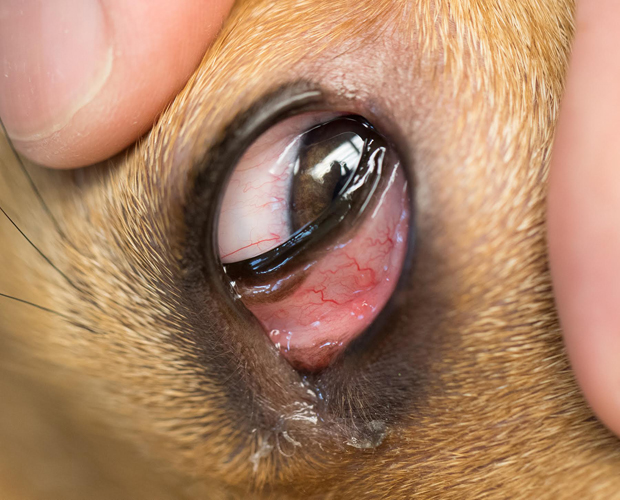By Dr. Carl Palazzolo, DVM, Long Beach Animal Hospital
Photos courtesy of LBAH except where indicated.

Graphic by A Dog’s Life Photo
Animals have a unique structure around the eye. It’s called the nictitating membrane, more informally known as the third eyelid. It isn’t actually an eyelid but a membrane that goes over the eye to protect it.

A normal nictitating membrane partially covering the eye.
Many animals have such membranes, in varying degrees and shapes. Dogs have one, and it can sometimes get inflamed. There is a gland on the inside of the eye that helps produce lubrication to keep the eye and the cornea moist and healthy. This gland can sometimes get inflamed and protrude from under the nictitating membrane, hence the term cherry eye.

What cherry eye looks like.
Several breeds are prone to this problem. They include mastiffs, cocker spaniels, Lhasa apsos, bulldogs, poodles, shih tzus and any of the breeds considered brachycephalic, or short-nosed breeds. It can occur in certain breeds of cats—the Burmese, for example—but it’s rare.
Pets with this problem are uncomfortable and need treatment. If left untreated, it can cause a problem called keratoconjunctivitis sicca (KCS), or dry eye resulting from a lack of tear production. This condition will be covered in next week’s column.
Once the gland protrudes, it might return to normal on its own, or it might need to be placed back behind the nictitating membrane and allowed to heal. In almost every case, it comes back. By the time we see most dogs with this problem, the gland has been present for several months and surgical correction is necessary.

The eye immediately after surgical correction. The gland is no longer protruding, and the nictitating membrane will slowly go back to its normal position and not cover the eye.
During surgery, we do not remove the gland. Doing so can cause the KCS problem years later. In the surgery, we make a pocket in the nictitating membrane and fold the gland into the pocket, suturing it into place. Most pets do well, and the problem never returns. Some pets are prone to the problem, or the gland may have been swollen and exposed for so long that the surgery needs to be repeated.

